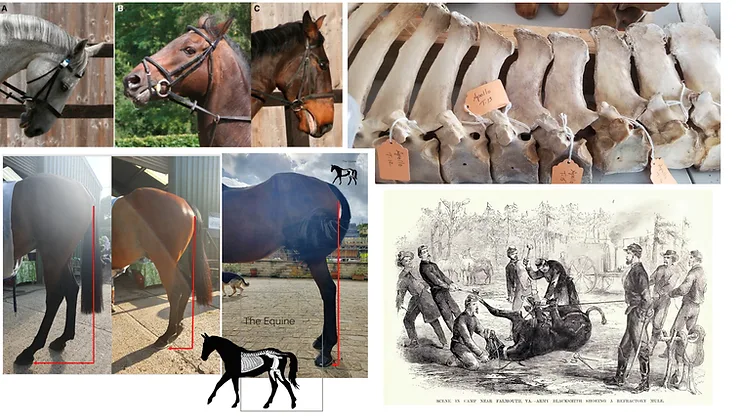
Many, many horses are in unrecognised pain. As their owners and caring professionals the responsibility lies with us to get better at recognising that pain, pro-actively assessing and monitoring our horses and looking out for the signs, rather than waiting for them to become in enough pain to be obviously lame.
Studies have shown that a huge amount of horses presumed sound are in fact lame, a recent study by Dyson et al (2019) took a random convenience selection of 20 horses, that were in regular work and found 16 of them to be lame, that’s a whopping 80%! This study built on a previous study (Mullard et al 2017) which created an ethogram to assess the facial expressions and behaviours in a first step toward easier recognition of lame horses, giving professionals a way of recognising pain over and above obvious gait or postural changes.
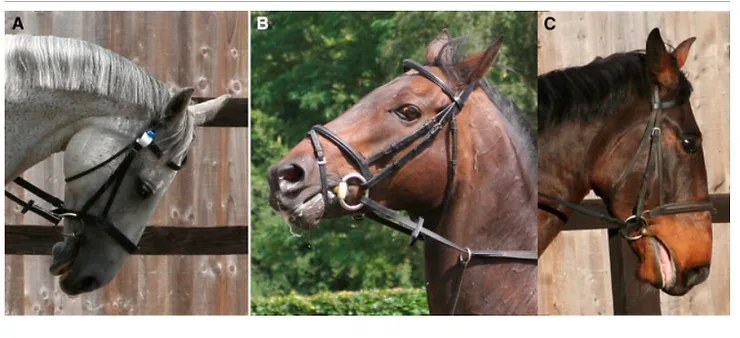
Mullard et al (2017)
The ethogram discovered 24 behavioural markers, the presence of 8 or more indicted musculoskeletal pain. It is becoming more recognised that drops in performance can also be attributed to musculoskeletal dysfunction (Dyson 2015) however studies show that the ability of riders and trainers to recognise this is poor and often the problem is put down to rider error, behaviour or even deemed normal for that horse. Owners, trainers and every type of practitioner has got to come to the realisation that horses are trying to tell us something.
Watch this video for more info. https://youtu.be/-9PxRo6PVCU
Horses are on the whole genuine in their behaviour, behaviours can be learnt from previous experiences but on the whole if a behaviour is pain induced they will tend to desist on relief of that pain, and studies have shown this, Cook (2003) for example found an immediate change in behaviour after the removal of a painful bit, and Dyson found a reduction in behaviours with the abolishment of pain in her studies. Gleerup and Lindegaard (2015) discussed in depth the recognition and quantification of pain in horses and in the authors opinion should be read by every owner. All of these studies clearly show that we must, and have a duty of care, to question behaviours. For the sake of the horse.
The are different technologies now available that can and perhaps should be utilised to monitor our horses and to recognise the beginnings of early dysfunction, pain and subtle lameness. Objective gait analysis is one of these, Serra Braganca et al (2018) suggested that lameness be defined as an assymetric gait caused by an underlying pathological dysfunction, objective gait analysis can quantitively measure these gait asymmetries, however small, helping us to identify musculoskeletal discomfort which we can then investigate and treat. Macechnie-Guire has done extensive research using the modality to show the effects of tack on the performance of horses and it will enable more future research into what we do to horses that makes them uncomfortable and how that can be improved, if we are going to use horses for our gain then we have a duty of care to ensure everything we do and put on them is not causing pain!
Read my article on objective gait analysis for further reading ( https://www.theequinedocumentalist.com/post/objective-lameness-assessment-and-kinematics )
Thermography is emerging as a tool in recognising physiological dysfunction, although it has been around for a long time, advances in standardisation, equipment and interpretation has meant more research can begin into its uses as an early stage pathology detector, Soroko and Howell (2018) expressed how its potential to recognise early onset of pathology could render it an important and pro-active preventative tool. The author took a personal interest in the technology in an attempt to address the questions asked by clients about behavioural and performance issues, it was apparent to the author that these horses were not comfortable but also not lame enough for nerve blocks, they needed a bridge technology that closed the gap between overt lameness and sub-clinical pain.
Read my article on Thermography for further reading ( https://www.theequinedocumentalist.com/post/equine-thermography-hot-or-not )
Farriers are well placed to recognise pain related behaviours, a horses stance, demeanour and response to being shod can all be tell tale signs, that is if the farrier is inclined to look. Mannsman et al (2011) outlined the fact that pain is an experience unique to the individual, expressed by the study which looked at horses with pathology and their behaviour to being shod, it found that horses which needed sedation for being shod no longer needed sedation after remedial shoeing and attributed this to being more comfortable, this strongly correlates with the authors experience in that as horses feet have come better over time the animal is better and better behaved while being shod. Mannsman et al (2011) ended by saying, before labelling a horse as badly behaved, first consider if it is in pain!! This has become an ethos of the author and should become a default question! An example of this is something often experienced by the author in flat footed horses, take both front shoes off and you will have a hard time, do one at a time and the horse is significantly better behaved and as the feet improve in solar depth and heel height over a series of shoeings (with appropriate remedial shoeing) there is usually further improvement in behaviour. Higher musculoskeletal pain can also have a significant effect on behaviour while being shod, in the authors experience of shoeing Negative Plantar Angles (NPA) in hind feet and the associated higher pathologies, the horses find it hard to stand well behind often jumping about.
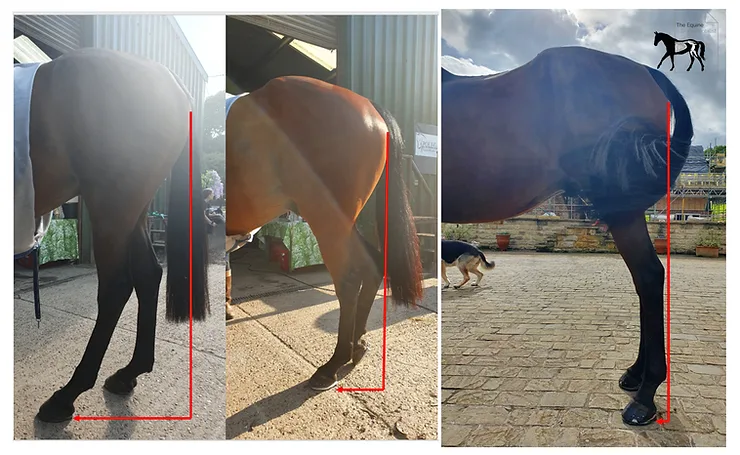
This picture shows the progression of stance as the hoof proportions were improved in a case of NPA, the improvement in stance which was also achieved with surgery and rehabilitation as well as farriery went hand in hand with a vast improvement in behaviour when being shod. This horse showed no signs of lameness, however he always presented with a stood under stance and struggled to stand being shod behind, the stance coupled with the authors ethos of, check for pain before labelling it an awkward horse, caused him to recommend further investigation, the horse had kissing spines, Sacro-illiac pain and inflamed suspensorys’. Had the author not of recommended this investigation it was only a matter of time before the horse would have broken, or at the very least continued to try his hardest for everyone despite being in pain.
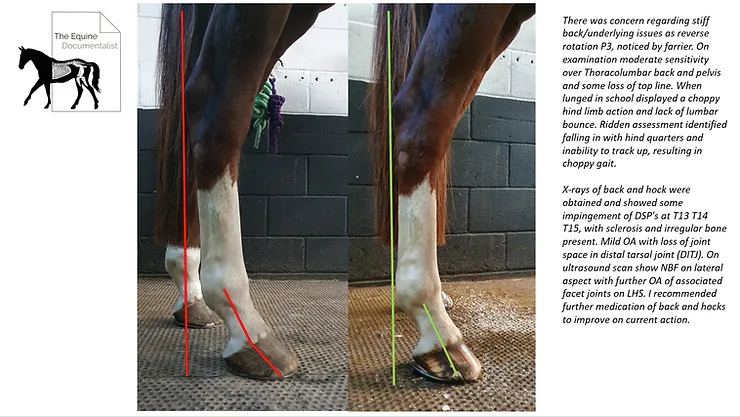
This picture shows another horse that the author advised for further investigation. a similar stance to the previous case, when the author asked if the horse displayed any lameness the reply was “She is a bit funny behind, but certainly not lame.” The vets findings appear in the picture. Once the diagnosis had been made, changes to the farriery along side body work began to compliment the veterinary treatment.
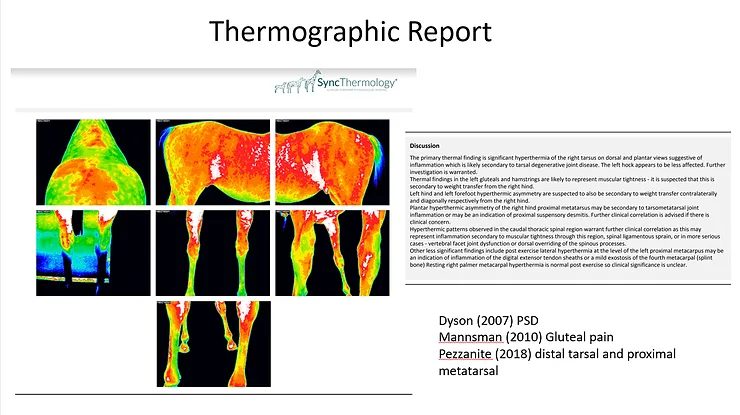
Thermography report of a horse presenting with the same stance as the previous cases, all of the pathologies linked with the stance were indicated and shows the importance of the recognition of stance as an indication of pain. Thermography has this unique ability to assess, non-inasivaly, the entire musculoskeletel system for physiological dysfunction which strongly correlates with pain.
Read my article on shoeing the hinds for more information on these conformations.
( https://www.theequinedocumentalist.com/post/what-about-the-hinds-shoeing-the-powerhouse )
These cases express how much horses will put up with pain and work through it because they are genuine animals! They also express how Farriers (and other practitioners) again are well placed, if they make assessments of the whole body, and ask the right questions, to recognise conformational defaults and stances that are linked to pathology, signalling potential pain, and make recommendations. Farriers should be welfare advocates and have whole horse care in mind, the horses comfort and well being must come above potential awkwardness with the client! On the whole owners are appreciative of the conscientiousness. If a horse is being difficult to shoe, ask why! If it stands with one foot forward, ask why! If it stands under itself, ask why! Learn the signals. For the sake of the horse.
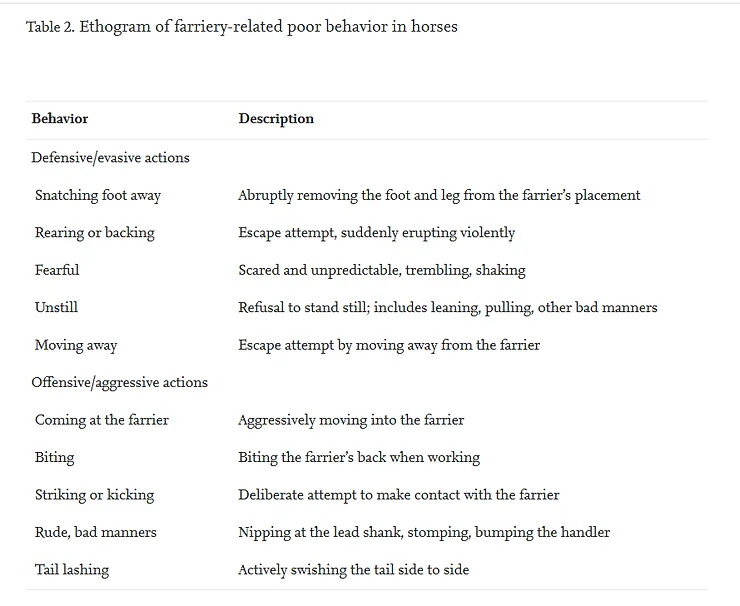
Mannsmann et al (2011) farriery ethogram. The study expressed that the behaviours can be the result of bad training, improper handling, or the recall of past pain/punishment but its findings correlated with Dyson and concluded that pain must be considered first.
A case that expresses the intent of this article and hopefully drives home its scientific evidence in an emotive way is that of Apollo.
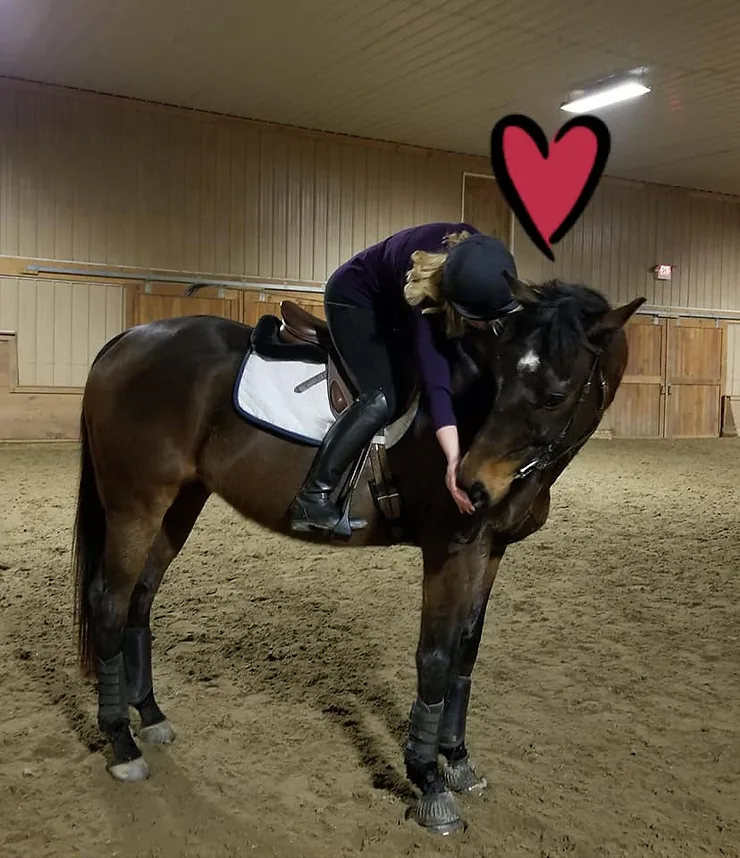
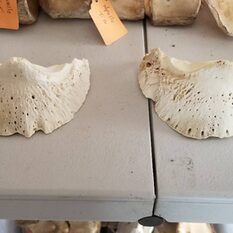
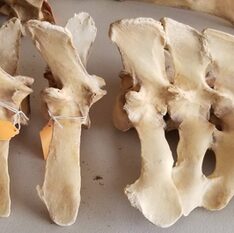
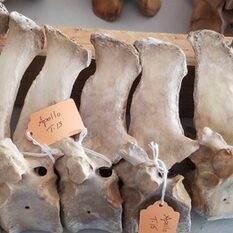
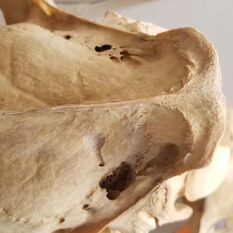
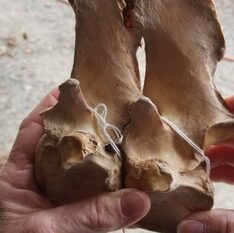
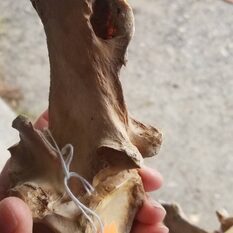
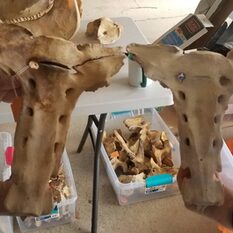
These bones tell a tale of a horse who tried his best despite the pain he felt everyday.
Apollo displayed many behaviours that pointed toward possible pain, this quote from his owner was some of the inspiration in writing this article.
“So. I got to visit Apollo’s bones today…and all that knew him certainly knew how difficult and sometimes dangerous he could be. Well his bones certainly told a story. A story of fused bones, bad kissing spine, abnormality in his front feet, and a very strange hole in his skull. Pamela Blades Eckelbarger will document, photograph and write in detail about him when she is settled back in SC. But here are some of the stuff I got to see today. And considering how bad some of his bones were, it was a miracle he was as “good” as he was. It was great closure for me, knowing I did the absolute best when I put him down and let him go…all his bad behavior came from pain, and a lot of it. He was not a bad horse, he just never had a chance to be anything else.”
The whole story can be found at
this story is touching, but unfortunately not uncommon and is a lesson to us all.
It is recognised in horses that changes in gait, stance, behaviour and even conformation are linked to pathology, but what we often forget is that will almost always indicate a level of pain. If your horse has flat feet, ok you may be getting away with it, but your horse will be in discomfort, this is only a small example of a huge issue, many of my articles are about being pro-active in addressing conformational faults and hoof morphology, not because it looks better but because disordered anatomy will inevitably mean pain! The owner is of course the common denominator, the horse cant speak, the farrier or any other practitioner may be recommending a certain intervention but the owner has to be the one to say “Do it”. Every professional involved with a horse has a responsibility to ask questions of behaviours and point out stance and conformations that may indicate pain, but the owner has just as much responsibility to investigate those points. Every owner also has to responsibility to educate themselves on what is ideal so they too can question disorder.
As I have become more and more aware of the implications of disordered anatomy I have become more insistent on the interventions I see as necessary. Its time our priorities became more appropriately placed, shiny tack and new Ariats must come second to ensuring the necessaries for the horses comfort, whether that be any form of remedial shoeing, regular physio, thermography scans, objective gait analysis, better fitting tack ect ect. They shouldn’t be in pain to meet our schedule or budget. If a horse is difficult in any area, firstly we must question if there is pain, then sufficient training or handling error. Let us remember that we are dealing with an innocent, on the whole genuine being, that can not express itself through anything other than its body language and behaviour.
Every person who is involved with horses has an obligation to familiarise themselves with the indications and predispositions of pain. For the sake of the horse.
For material and clinics on the subjects mentioned please contact the author.
References
Evaluation of poor performance in competition horses: A musculoskeletal perspective. Part 1: Clinical assessment
First published: 20 August 2015
https://doi.org/10.1111/eve.12426
Application of a ridden horse ethogram to video recordings of 21 horses before and after diagnostic analgesia: Reduction in behaviour scores
First published: 10 December 2018
https://doi.org/10.1111/eve.13029
Development of an ethogram to describe facial expressions in ridden horses (FEReq)
JessicaMullardaJeannine M.BergerbAndrea D.ElliscSueDysona
Show more
https://doi.org/10.1016/j.jveb.2016.11.005
F.M.Serra Bragança, aM.Rhodinb, P.R.van Weerena, On the brink of daily clinical application of objective gait analysis: What evidence do we have so far from studies using an induced lameness model? The Veterinary Journal, vol 234, 2018, pg 11-23
Cook, W. (2003) Bit‐induced pain: a cause of fear, flight, fight and facial neurolgia in the horse. Pferdeheilkunde 19, 75‐82.
Equine Behavior Problems—Around Farriery: Foot Pain in 11 Horses
Richard A.MansmannVMD, PhD, Hon DACVIM-LAaM. ClaireCurrieDVMabMaria T.CorreaPhDcBarbaraShermanDVM, PhD, DACVBaKurtvom Orded
Show more


